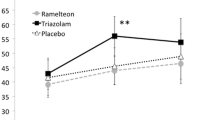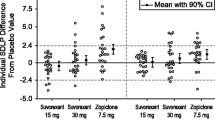Abstract
Rationale
Sedation following antihistamine use poses a danger to ambulant patients involved in daily activities such as driving.
Objective
To investigate effects of levocetirizine (5 mg), diphenhydramine (50 mg), and placebo on driving ability during normal traffic.
Methods
Forty-eight healthy volunteers participated in a double-blind, placebo-controlled, randomized clinical trial. Treatments were administrated on days 1, 2, 3 and 4, exactly 1.5 h before the start of the standardized driving test (performed on day 1 and day 4). In the standardized driving test, subjects were instructed to drive with a steady lateral position, while maintaining a constant speed (95 km/h). Primary parameter was the standard deviation of lateral position (SDLP; cm). Statistical analyses were performed separately for day 1 and day 4, using analysis of variance and an equivalence test. Equivalence to placebo was evidenced if the 95% confidence interval lay between −2.6 cm and +2.6 cm.
Results
SDLP after levocetirizine was equivalent to placebo on both day 1 (−0.66 cm; +1.12 cm) and day 4 (−0.37 cm; +1.28 cm). In contrast, SDLP after diphenhydramine differed significantly from placebo on both day 1 (P<0.0001) and day 4 (P<0.0003). On day 1, the 95% confidence interval of diphenhydramine (+1.85 cm; +3.63 cm) was partially above the upper equivalence limit (+2.6 cm), indicating clinically relevant driving impairment. On day 4, however, the 95% confidence interval of diphenhydramine (+0.74 cm; +2.38 cm) was contained within the acceptance range.
Conclusion
In contrast to diphenhydramine, driving performance was not significantly affected while using 5 mg levocetirizine once daily.


Similar content being viewed by others
References
Blanc PD, Trupin L, Eisner M et al. (2001) The work impact of asthma and rhinitis: findings from a population-based survey. J Clin Epidemiol 54:610–618
Boonyaratevej N, Suriyawongpaisal P, Takkinsatien A, Wanvarie S, Rajatanavin R, Apiyasawat P, the Thai Osteoporosis Study Group (2001) Physical activity and risk factors for hip fractures in Thai women. Osteoporos Int 12:244–248
Borkenstein RF, Crowther RP, Shumate RP, Ziel HB, Zylman R (1964) The role of the drinking driver in traffic accidents. Dept. of Police Administration, Indiana University, Bloomington, Indiana
Cauci M, King MG, Saxarra H, Tulloch BJ, Husband AJ (1993) A Minnesota Multiphasic Personality Inventory profile of women with allergic rhinitis. Psychosom Med 55:533–540
Clough GF, Boutsiouki P, Church MK (2001) Comparison of the effects of levocetirizine and loratadine on histamine-induced wheal, flare, and itch in human skin. Allergy 56:985–988
Devalia JL, De Vos C, Hanotte F, Baltes E (2001) A randomized, double-blind, crossover comparison among cetirizine, levocetirizine and UCB 28557 on histamine-induced cutaneous responses in healthy adult volunteers. Allergy 56:50–57
Didier A, Doussau-Thuron S, Murris-Espin M (2000) Comparative analysis of sedative effects of mequitazine and other antihistamine drugs: review of the literature. Curr Ther Res Clin Exp 61:770–780
Fireman P (1997) Treatment of allergic rhinitis: effect on occupation productivity and work force costs. Allergy Asthma Proc 18:63–67
Gandon JM, Allain H (2002) Lack of effect of single and repeated doses of levocetirizine, a new antihistamine drug, on cognitive and psychomotor functions in healthy volunteers. Br J Clin Pharmacol 54:51–58
Gengo FM, Gabos C (1987) Antihistamines, drowsiness, and psychomotor impairment: central nervous system effect of cetirizine. Ann Allergy 59:53–57
Gengo FM, Gabos C, Miller JK (1989) The pharmacodynamics of diphenhydramine-induced drowsiness and changes in mental performance. Clin Pharmacol Ther 45:15–21
Gengo FM, Gabos C, Mechtler L (1990) Quantitative effects of cetirizine and diphenhydramine on mental performance measured using an automobile driving simulator. Ann Allergy 64:520–526
Gillard M, Van der Perren C, Moguilevsky N, Massingham R, Chatelain P (2002) Binding characteristics of cetirizine and levocetirizine to human H1 histamine receptors: contribution of Lys191 and Thr194. Mol Pharmacol 61:391–399
Gilmore TM, Alexander BH, Mueller BA, Rivara FP (1996) Occupational injuries and medication use. Am J Ind Med 30:234–239
Hindmarch I, Johnson S, Meadows R, Kirkpatrick T, Shamsi Z (2001) The acute and sub-chronic effects of levocetirizine, cetirizine, loratadine, promethazine and placebo on cognitive function, psychomotor performance, and weal and flare. Curr Med Res Opin 17:241–255
Jones B, Jarvis P, Lewis JA, Ebbutt AF (1996) Trials to assess equivalence: the importance of rigorous methods. BMJ 313:36–39
Kay GG (2000) The effects of antihistamines on cognition and performance. J Allergy Clin Immunol 105:S622–S627
Kay GG, Quig ME (2001) Impact of sedating antihistamines on safety and productivity. Allergy Asthma Proc 22:281–283
Kay GG, Berman B, Mockoviak SH, Morris CE, Reeves D, Starbuck V et al (1997) Initial and steady-state effects of diphenhydramine and loratadine on sedation, cognition, mood and psychomotor performance. Arch Intern Med 157:2350–2356
Leynadier F, Mees K, Arendt C, Pinelli M-E (2001) Efficacy and safety of levocetirizine in seasonal allergic rhinitis. Acta Otorhinolaryngol Belg 55:305–312
Louwerens JW, Gloerich ABM, De Vries G, Brookhuis KA, O'Hanlon JF (1987) The relationship between drivers' blood alcohol concentration (BAC) and actual driving performance during high speed travel. In: Noordzij PC, Roszbach R (eds) Alcohol, drugs and traffic safety. Proceedings of the 10th International Conference on Alcohol, Drugs and Traffic Safety, Amsterdam, Excerpta Medica, pp 183–192
Marshall PS, Colon EA (1993) Effects of allergy season on mood and cognitive function. Ann Allergy 71:251–258
Mattila MJ, Mattila M, Konno K (1986) Acute and subacute actions on human performance and interactions with diazepam of temelastine (SK&F93944) and diphenhydramine. Eur J Clin Pharmacol 31:291–298
Moskowitz H, Burns M (1988) Effects of terfenadine, diphenhydramine, and placebo on skills performance. Cutis 42:14–18
Nolen TM (1997) Sedative effects of antihistamines: safety, performance, learning and quality of life. Clin Ther 19:39–55
O' Hanlon JF (1984) Driving performance under the influence of drugs: rationale for, and application of, a new test. Br J Clin Pharmacol 18:121S–129S
O'Hanlon JF, Ramaekers JG (1995) Antihistamine effects on actual driving performance in a standard test: a summary of Dutch experience. Allergy 50:234–242
O'Hanlon JF, Haak TW, Blaauw GJ, Riemersma JBJ (1982) Diazepam impairs lateral position control in highway driving. Science 217:79–81
Ramaekers JG, O'Hanlon JF (1994) Acrivastine, terfenadine and diphenhydramine effects on driving performance as a function of dose and time after dosing. J Clin Pharmacol 47:261–266
Rice VJ, Snyder HL (1993) The effects of Benadryl and Histamal on psychomotor performance and perceived performance. Aviat Space Environ Med 64:726–734
Roehrs T, Zwyghuizen-Doorenbos, Roth T (1993a) Sedative effects and plasma concentrations following single doses of triazolam, diphenhydramine, ethanol and placebo. Sleep 16:301–305
Roehrs T, Claiborue D, Knox M, Roth T (1993b) Effects of ethanol, diphenhydramine, and triazolam after a nap. Neuropsychopharmacology 9:239–245
Röhmel J (1998) Therapeutic equivalence investigations. Statistical considerations. Stat Med 17:1703–1714
Roth T, Roehrs T, Koshorek G, Sicklesteel J, Zorick F (1987) Sedative effects of antihistamines. J Allergy Clin Immunol 80:94–98
Schweitzer PK, Meuhibach MJ, Walsh JK (1994) Sleepiness and performance during three-day administration of cetirizine or diphenhydramine. J Allergy Clin Immunol 94:716–724
Simons FER (1999) H1-receptor antagonists: safety issues. Ann Allergy Asthma Immunol 83:481–488
Snyder SH, Snowman AM (1987) Receptor effects of cetirizine. Ann Allergy 59:4–8
Spaeth J, Klimek I, Mösges R (1996) Sedation in allergic rhinitis is caused by the condition and not by the antihistamine treatment. Allergy 51:893–906
Verster JC, Volkerts ER, van Oosterwijck AWWA, Aarab M, Bijtjes SIR, de Weert AM, Eijken EJE, Verbaten MN (2003) Acute and subchronic effects of levocetirizine and diphenhydramine on memory functioning, psychomotor performance, and mood. J Allergy Clin Immunol 111:623–627
Volkerts ER, Van Laar MW (1995) Specific review of psychometric effects of cetirizine. Allergy 50:55–60
Volkerts ER, van Willigenburg PP, van Laar MW, Maes RAA (1992) Does cetirizine belong to the new generation of antihistamines? An investigation into its acute and subchronic effects on highway driving, psychometric test performance, and EEG during driving. Hum Psychopharmacol 7:227–238
Vuurman EPFM, Van Veggel LMA, Uiterwijk MMC, Leutner D, O'Hanlon JF (1993) Seasonal allergic rhinitis and antihistamine effects on children's learning. Ann Allergy 71:121–126
Vuurman EFPM, Van Veggel LMA, Sanders RL, Muntjewerff ND, O'Hanlon JF (1996) Effects of semprex-D and diphenhydramine on learning in young adults with seasonal allergic rhinitis. Ann Allergy Asthma Immunol 76:247–252
Wang DY, Hanotte F, De Vos C, Clement P (2001) Effect of cetirizine, levocetirizine, and dextrocetirizine on histamine-induced nasal response in healthy adult volunteers. Allergy 56:339–343
Weiler JM, Bloomfield JR, Woodworth GG, Grant AR, Layton TA, Brown TL et al (2000) Effects of fexofenadine, diphenhydramine, and alcohol on driving performance. Ann Intern Med 132:354–362
Wilken JA, Berkowitz R, Kane R (2002) Decrements in vigilance and cognitive functioning associated with ragweed-induced allergic rhinitis. Ann Allergy Asthma Immunol 89:372–380
Acknowledgement
This study was financially supported by UCB Pharma.
Author information
Authors and Affiliations
Corresponding author
Rights and permissions
About this article
Cite this article
Verster, J.C., de Weert, A.M., Bijtjes, S.I.R. et al. Driving ability after acute and sub-chronic administration of levocetirizine and diphenhydramine: a randomized, double-blind, placebo-controlled trial. Psychopharmacology 169, 84–90 (2003). https://doi.org/10.1007/s00213-003-1462-6
Received:
Accepted:
Published:
Issue Date:
DOI: https://doi.org/10.1007/s00213-003-1462-6




